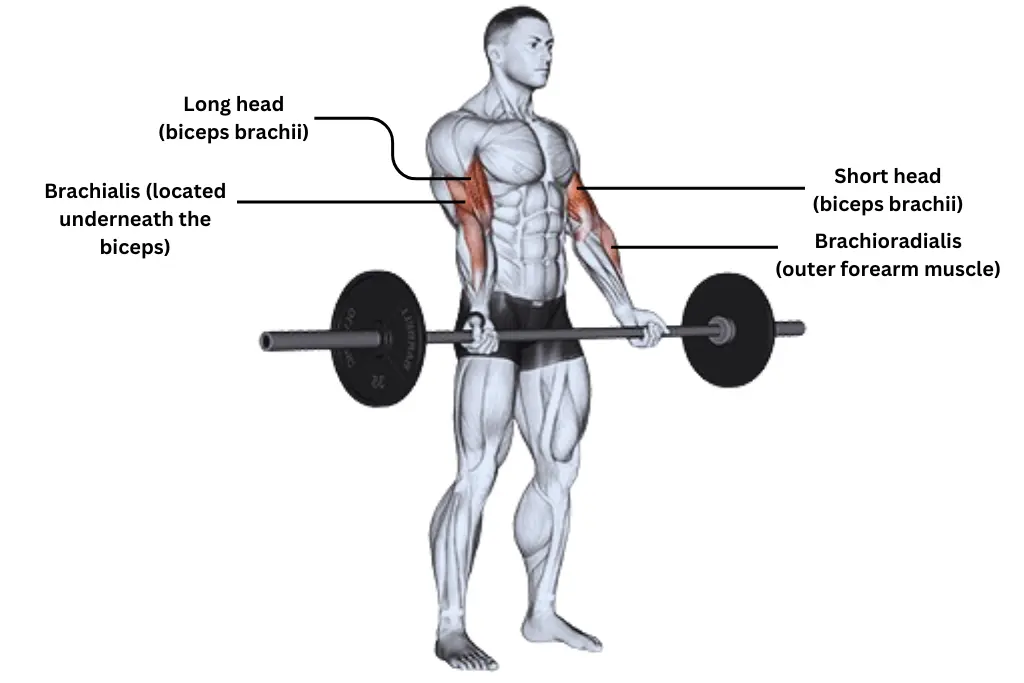With the invention of the barbell in the 1860s, athletes and fitness enthusiasts gained access to a game-changing tool for enhancing bicep development.
Barbell curls are a simple yet effective exercise that many use and will be using to gain bigger biceps.
Many barbell exercises for biceps could be done in today’s age to develop the biceps, but old-school barbell curls will always be first on our list.
This classic exercise targets the biceps brachii along with the brachialis (muscle underneath the biceps) and brachioradialis (outer forearm muscle), helping in overall upper arm development.
Let’s delve into the proper form and techniques to maximize the benefits of this exercise.
Benefits of the Barbell Curl
Barbell curls have many benefits, but here are the top two:

Multiple Muscle Activation
While performing barbell curls, not only are your biceps activated, but this workout also works the outer forearm muscle along with the brachialis (the muscle beneath the biceps).
Improved Grip
Most of the exercises you do with a barbell or other gym equipment, whether it is a full-body workout or just for biceps workouts, you have to have a proper grip.
Holding the barbell with a supinated grip (palms facing up) helps your wrist, shoulder, and elbows stay aligned, making your grip stronger. This improved grip can be beneficial with things you do outside exercising, such as holding heavy grocery bags or pushing the cart when you go shopping.
How to Do Barbell Curls
How to Perform it:
- Stand straight and load the barbell with appropriate weights, or use the barbell alone.
- Relax your body, extend your elbows, and keep them close to your torso.
- Lift the bar towards your chest, squeezing the biceps at the top.
- Lower the barbell down slowly and controlled, arms fully extended.
- Breathe out as you lift the bar, and breathe in as you lower it.
Equipment: Standard Barbell
Primary Muscle Worked: Biceps
Tips for Proper Form
Form is essential for any exercise you perform; without proper form, barbell curls will not have much effect on your biceps. Here are three tips to maintain proper form:
Maintain a Proud Chest and Shoulders
When your chest and shoulders are lazy throughout the exercise, you create less tension on your biceps to let them reach their full potential.
In simple words, you’re wasting your time and stopping your gains.
Do a full range of motion while keeping your chest and shoulders aligned with your body.
Avoid Lifting Heavy Weights
Overloading the barbell with heavy weights will cause you to lose momentum throughout the exercise. This reduces the effectiveness of barbell curls, making them feel as light as lifting two buckets of paper. As a result, you won’t get as much muscle work as you need.
Controlled Movement When Going Down
When lowering the bar back to the starting position, focus on controlling your movement.
Doing this helps maintain tension in your muscles throughout the exercise, making the movement effective.
Common Mistakes
Avoid these common mistakes to make barbell curls more effective.
Not Considering Wrist Pain
Pushing through wrist pain can put too much strain on your wrist, not to mention the potential for other injuries. This could occur when the wrist is not in the correct form.
Specifically, when lifting the bar, it’s crucial to maintain straight wrists without bending them downward or forward.
Bending your wrists downward during curls can create negative tension in your forearm flexor muscles while bending them forward can stress your wrist extensor muscles.
Bad Posture
Even though it’s basic, posture remains an essential factor in performing barbell curls correctly.
When your spine is curved, your buttocks stick out, or your neck is forward, you’re not completing the full range of motion, and you’re also putting strain on your spine.
If you find yourself struggling with poor posture, it’s likely due to your daily habits. Fix it by doing posture exercises.
Elbows Resting on the Torso
When curling, keeping the elbows close to the torso reduces tension on the biceps and focuses on other muscles.
This often occurs when using inappropriate weights on the bar. Instead, ensure the elbows are slightly in line with the wrist and shoulder for optimal form.
Final Thoughts
Barbell curls are indeed effective, but if you’re experiencing wrist pain, you should try alternative tools.
We recommend trying the EZ bar curls, as the EZ bar’s unique gripping style puts less stress on your wrists. Once your biceps are decent, you can always return to barbell curls.
Featured image by iStock edited by SA